![]()
![]()
![]()
Use LEFT and RIGHT arrow keys to navigate between flashcards;
Use UP and DOWN arrow keys to flip the card;
H to show hint;
A reads text to speech;
355 Cards in this Set
- Front
- Back
|
What do protiens contain
|
C H N O and maybe S
|
|
|
Briefly describe protiens
|
extremly complex molecules witha a wide variety of functions
|
|
|
What are all protiens composed of
|
amino acids
|
|
|
What links proteins and amino acids?
|
peptide bonds
|
|
|
What is used to classify protiens
|
structure or function
|
|
|
How many different protien structures are there? What are they?
|
four
primary secondary teritary quatrinary |
|
|
Describe a primary protein structure
|
a long one dimensional chain of amino acids joined by peptide bonds
|
|
|
Describe a secondary protein structure
|
when amino acid chain folds into a pleated sheet or coils into a helix
|
|
|
Describe a teritery protein structure
|
when the amino acid chain folds back on itself so that amino acids that were on opposite ends end up next to eachother
|
|
|
describe quatrinary protein structure
|
2 or more amino acid chains that twist together
|
|
|
What happens to a secondary, teritary or quatrinary protein when it encounters a hostile environment?
|
it unravels and loses its structure becoming a primary chain
|
|
|
what is a denatured protein?
|
when a protein enters a hostile environment and unravels into a primary structure. This renders the protein usless and it cannot function.
|
|
|
How many protein function classifications are there? Name them
|
5
catalytic proteins transport proteins immunilogical proteins structural proteins contractual proteins |
|
|
Catalytic proteins
|
enzymes that speed up chemical reactions
|
|
|
transport proteins
|
carry substance in the body
ex: hemoglobin carries O2 into blood |
|
|
Immunilogical proteins
|
enzymes that fight infection
|
|
|
structural proteins
|
build body structures
ex: collagen |
|
|
contractual proteins
|
actin and myocin (located in the sarcomere)
|
|
|
What are enzymes
|
specialized proteins that speed up chemical reactions by lowering the activation energy needed for the reaction to occur. (lowers ATP)
|
|
|
What is a complete enzyme called/.
|
holoenzyme
|
|
|
What does a complete enzyme consist of?
|
a protein and non-protein part
|
|
|
What is the protein part of an enzyme called
|
apoenzyme
|
|
|
what is the non protein part of an enzyme called?
|
either a coenzyme in an organic enzyme or a cofactor in a metal ion enzyme
|
|
|
most enzymes end with the suffix
|
-ase
|
|
|
substrates
|
molecules in the body that enzymes are specialized to react to in the body. The enzyme will ignore everything else but the substrate.
|
|
|
Active site
|
located on the surface of the substrate (cell) where the substrate and an enzyme combine
|
|
|
induced fit
|
the process of the substrate and the enzyme combining together.
Like a lock and key |
|
|
what happens when induced fit occurs
|
products are produced and reactions occur.
|
|
|
what happens after the induced fit reaction
|
the enzyme and substrate split and the enzyme is free to cause another reaction.
|
|
|
What is the biggest molecule in our body?
|
Nucleic Acids
|
|
|
What is the basic unit of structure for a Nucleic Acid
|
nucleotide
|
|
|
What makes up the nucleotide structure
|
pentosugar
phosphate group nitrogen base |
|
|
What is a pentosugar
|
Part of the nucleotide structure made up of either deoxyribose (DNA) or ribose (RNA)
|
|
|
what is a phosphate group?
|
part of the nucleotide structure. It forms the backbone of the nucleic acid
|
|
|
What is a nitrogen base
|
the third part of the nucleotide structure. Can be thyamine, uracil, adenine, guanine, cytosine.
|
|
|
Describe and compare the size and location of both DNA vs RNA
|
DNA: an extremly large molecule that is only found in the nucleus. It can never leave.
RNA: about 1/2 the size of DNA but is still big. Found in both nucleus and cytoplasm. |
|
|
Compare the function of DNA vs RNA
|
DNA: controls our heredity or genetic makeup. It contains the instructions for making every protein in our body. Everyones is unique except identical twins.
RNA: Carries out DNA's instructions for making protein. Forms the small subunit of the ribosome. Brings amino acids into the ribosome so proteins can be made. |
|
|
Compare the shape of DNA vs RNA
|
DNA: is a double stranded molecule twisted in to a helix.
RNA: always a single strand that can be long or folded. |
|
|
Compare the sugars that make up DNA vs RNA
|
DNA: deoxyribose
RNA: ribose Both are a pentose and a carbohydrate. |
|
|
compare the nucleic bases used in DNA vs RNA
|
DNA: A,G,C,T
RNA: A, G, C, U *T and U are the same thing. |
|
|
Compare the nucleic base pairing in DNA vs RNA
|
DNA: A=T; G=C
RNA: A=U; G=C |
|
|
What links bases in both DNA and RNA
|
Hydrogen bonds which are weak and easily break
|
|
|
What are the 3 types of RNA
|
mRNA
rRNA tRNA |
|
|
mRNA
|
messenger RNA the copy of DNA that carries the genetic code to the ribosome
|
|
|
rRNA
|
ribosomal RNA. small subunit of the ribosome
|
|
|
tRNA
|
transfer RNA. transfers amino acids from cytoplasm to ribosome so protein can be made.
|
|
|
What does C H N O P stand for
|
C= carbohydrate - the deoxyribose or ribose
H= Hydrogen N= Nitrogen base O= Oxygen P= Phosphate group |
|
|
What determines our genetic make-up
|
the proteins that make up DNA. conatins the blueprint for making every protien in our body.
|
|
|
How is it determined what protein will be made?
|
The number, kind and order of our amino acids.
|
|
|
How many amino acids are in our body.
|
20
|
|
|
How many amino acids are typically in a protein?
|
4 So they show up many times.
|
|
|
1 amino acids is coded by
|
3 bases
|
|
|
triplets
|
3 bases found on DNA
|
|
|
codons
|
3 bases on mRNA
|
|
|
anticodons
|
3 bases on tRNA
|
|
|
transcription
|
the 1st step in making a protein
|
|
|
Where does transcription occur?
|
always in the nucleus
|
|
|
how does DNA start copying
|
by forming a strand of mRNA
|
|

What is this a picture of
|
A single DNA strand
|
|
|
What do the letters stand for in 2?
|
Deoxyribose and Phosphate
|
|
|
RNAP does....
|
RNA polymerase: attaches to a receptor site on the end of DNA
|
|
|
What happens after rNAP attaches to DNA
|
causes the DNA molecule to uncoil from its helix, breaks the hydrogen bond between the nitrogen bonds resulting in 2 seperate strands.
|
|
|
How is mRNA constructed.
|
RNAP reads 1 of the strands and contructs a complimentary strand.
|
|
|
What is the complimentary mRNA strand called?
|
the sense strand
|
|
|
anti-sense
|
the DNA strand that is not read by RNAP
|
|
|
How does RNAP read the DNA strand?
|
It is non selective and intially copys everything from DNA
|
|
|
exons
|
info in DNA that codes for protein.
|
|
|
introns
|
Infor that odes not code for protein on DNA. It stays in the nucleus and disintigrates.
|
|
|
SNURPS and function
|
Subnuclear Ribonucleic Proteins.
cut introns out of the mRNA strand and splice the exons together. |
|
|
What is contained on mRNA after it leaves the nucleus
|
exons aka only info containing proteins.
|
|
|
Biochemistry
|
the study of organic chmeicals
|
|
|
Every organic material contains
|
some carbon and hydrogen
|
|
|
What are the 5 types of organic molecules
|
carbons
lipids proteins nucleic acids ATP |
|
|
What are the 3 main stages of protein synthesis
|
transcription
translation termination |
|
|
How does transcription end?
|
the sense and antisense strand swing back together and the hydrogen bond reforms between the bases. DNA then twists back into a helix
|
|
|
what is the initiator codon?
|
AUG
|
|
|
What are the stop codons
|
UAA
UAG UGA When the ribosome reads any one of those it stops making protein. |
|
|
Translation
|
when the genetic code that is now carried in mRNA is translated into a protein.
|
|
|
Where does translation occur
|
in the cytoplasm at the ribosome.
|
|
|
How does trnaslation start
|
mRNA comes out to the ribosome rRNA and attaches to a receptor stie on the end of mRNA
|
|
|
Initiation
|
when rRNA reads the codon "AUG" the large and the small subunits (protein and rRNA) lock together and start making protein.
|
|
|
What completes initiation?
|
the first tRNA and its amino acid enter the p-site of the ribosome and the codon and anti codon bind.
|
|
|
What is the first protein made in the body?
|
methionine
|
|
|
What is the 2nd stage of translation?
|
elongation
|
|
|
Elongation
|
the lengthening of the aa chain
|
|
|
How does elongation begin?
|
the 2nd codon is read and the 2nd tRNA and its amino acid enther the a-site. Codon and anticodon bind and
|
|
|
during elongation, what happens after the codon and anitcodon bind?
|
a peptide bond forms between aa1 and aa2 thus filing the ribosome
|
|
|
When the ribosome is filled what happens to the 1st tRNA and its aa?
|
the ribosome then jumps to the 3rd codon and the tRNA that was in the psite is now in the cytoplasm
|
|
|
what happens to the tRNA after it leaves the p-site
|
The hydrogen bond between the 1st aa and tRNA break and the tRNA is free to grab another methionine.
|
|
|
When the p-site "space" becomes available what happens to it?
|
the 2nd tRNA and its aa that were in the a site move to the p site, leaving the a site empty.
|
|
|
Termination
|
eventually the ribosome reads one of the stop codons
|
|
|
release factor
|
activated when a stop codon is read. Once activated the enzyme splits the ribosome back into 2 subunits and then cuts the protein away.
|
|
|
2 ribosome subunits
|
protein and rRNA
|
|
|
ATP
|
the prefered source of energy for our body.
|
|
|
How is ATP made?
|
its generated in the mitochondria from the oxidation of sugar, aa's fatty aids and glycerol.
|
|
|
Digestion
|
both the chemical and physical breakdown of complex food into its component parts.
|
|
|
What happens to the component parts in digestion
|
some of it is reabsorbed and some of it is removed.
|
|
|
2 groups of digestive organs
|
alimentary canal
accessory structures |
|
|
alimentary canal
|
mouth
pharynx esophagus stomach SI LI |
|
|
Accessory structures
|
teeth
toungue salivary glands liver gall bladder pancreas |
|
|
histology of the Alimentary canal (4 parts
|
mucosa
submucosa muscularis serosa |
|
|
mucosa
|
the inner lining. simple columnar with goblets and lymph nodes
|
|
|
submucosa
|
its a vascular CT membrane. Binds the mucosa to the muscularis
|
|
|
muscularis
|
skeletal muscle tissue. Mostly outermostly in the mouth throat and esophogus. produces the voluntary movement of swallowing.
|
|
|
serosa
|
the outer layer the visceral peritineum.
|
|
|
What are the 5 membranes of the digestive system
|
peritineum
mesentary mesocolon greater omentum falciform ligament |
|
|
mesentary
|
binds the SI's together in the DS.
|
|
|
mesocolon
|
binds the LI to the posterior body wall in the DS
|
|
|
greator omentum
|
a large apron of fat that hangs down from the stomach over the intestines. contains mostly adipose and lymph nodes
|
|
|
falciform ligament
|
attaches liver to the diaphram and to the anterior body wall.
|
|
|
Food intake is controlled by
|
the hypothalamus
|
|
|
2 regions of hypothalamus for food intake
|
feeding center
satiety center |
|
|
feeding center
|
region of the hypothalamus that, when active, you cannot stop eating even if you are full.
|
|
|
satiety center
|
you wont eat even if you are starving.
|
|
|
What are the 2 types of digestion
|
physical and chemical
|
|
|
physical/mechanical digestion (5)
|
chewing
moving swallowing mixing churning |
|
|
chemical digestion
|
consists of all the reactions that that break food down into its component parts
|
|
|
the bucal cavity
|
the mouth
|
|
|
major tissue in the mouth
|
stratified squamous non keratinzed and completly covered with mucous membrane
|
|
|
vestibule
|
the space between the lips teeht and cheeks
|
|
|
mechanical digestion in the mouth
|
when you chew food and mix it with saliva to form a bolus
|
|
|
bolus
|
food chewed and mixed with saliva
|
|
|
chemical digestion in the mouth
|
initial digestion of starch with salivary amylase
|
|
|
lingual lipase
|
enzyme secreted by glands in the tongue that begin the digestion of fat. However, in most cases the food is swallowed too quickly and the enzymes are denatured before digestion is complete.
|
|
|
3 types of salivary glands
|
parotid
sublingual submandibular and submaxillary |
|
|
parotid
|
the largest salivary gland slightly in front of and below each ear. produces most of our saliva
|
|
|
sublingual
|
salivary glands underneath the tongue, toward the front. Produce thick mucus like saliva. Very active under stress
|
|
|
submandibular and submaxillary
|
salivary glands at the junction of the maxilla dn mandible. Produce a thin watery saliva
|
|
|
Saliva
|
99.5% water .5% solute
|
|
|
Solutes in saliva
|
Na, K, chloride, bicarbonate, phosphate ions. Lysozyme, salivary amylase, and ligual lipase.
|
|
|
lysozyme
|
an enzyme that kills bacteria
|
|
|
Tongue
|
located in the mouth. anchored by the hyoid bone.
|
|
|
tongue is made of
|
skeletal muscle tissue covered by mucous membrane
|
|
|
papillae on tongue.
|
bumps on the surface that make up the taste buds
|
|
|
5 taste senses
|
salt
sour bitter sweet umami |
|
|
lingual septum
|
divides the tongue in 1/2
|
|
|
lingual frenulum
|
a mucous membrane underneath the tongue
|
|
|
2 muscles associated with the tongue
|
extrinsic
intrinsic |
|
|
extrinsic tongue muscles
|
in and out
up and down |
|
|
intrinsic tongue muscles
|
alters size and shape of tongue during speech and swallowing.
|
|
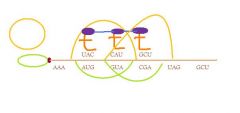
what is this a picture of
|
an mRNA strand
|
|
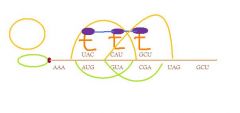
What does the orange circle/curves represent
|
protein
|
|
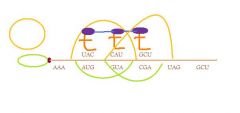
What does the green circle/curve represent?
|
rRNA
|
|
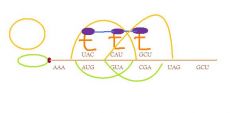
What do both the orange circle and green circle make up together
|
a ribosome
|
|
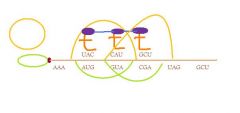
Which codon is the stop codon?
|
UAG
|
|

What are the codons on top of the mRNA strand refered to?
|
anti codons
|
|
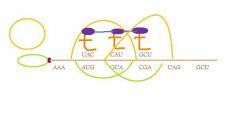
what do the purple circles represent
|
amino acids
|
|

What does the Orange line (connected to the purple circle down to the strand) represent?
|
tRNA
|
|
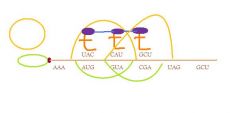
What does the blue line between the purple circles represent
|
the hydrogen bond.
|
|
|
What are the four types of teeth and how many do we have of each?
|
incissors 4
canine 2 premolars/bicuspids 4 molars 6 |
|
|
How do childrens teeth differ from an adult
|
children have no bicuspids and only 4 molars
|
|
|
crown
|
part of the tooth above the gum line covered with enamel
|
|
|
enamel
|
hardest substance in the body. Covers teeth
|
|
|
root
|
between 1 and 3 projections called root canals, covered by cementum
|
|
|
what are teeth made of
|
calcified connective tissue, called dentin
|
|
|
pulp cavity
|
deep in the crown of the tooth where blood vessels and nerves are located
|
|
|
apical foramen
|
a tiny hole in the base of each root canal where blood vessels and verves enter and exit the tooth.
|
|
|
alveolar process
|
the socket in which the tooth sits
|
|
|
peiodontal ligaments
|
line the alveolar process
|
|
|
gomphosis
|
the joint formed by a tooth in a socket
|
|
|
the neck
|
the junction point of the crown and the root, located at or slightly below gum line.
|
|
|
deglutition
|
swallowing
|
|
|
swallowing
|
the process that moves bolus from the mouth to the esophogus, requires both saliva and mucous
|
|
|
3 stages of swallowing
|
voluntary
pharyngeal esophageal |
|
|
voluntary swallowing
|
the movement of bolus from the mouth to the throat
|
|
|
pharyngeal swallowing
|
the involuntary movement of bolus through the throat and into the esophagus
|
|
|
What 2 things should occur during pharyngeal swallowing?
|
-soft palette should rise closing off the nasal region.
the epiglottis should tip upward and close off the trachea |
|
|
esophageal swallowing
|
the movement of bolus through the esophagus and into the stomach
|
|
|
the esophogus is coated with
|
mucous
|
|
|
peristalsis
|
movement through the esophogus. A contraction of the muscularis that moves contents through the GI tract. It is always strongest proximal and weakens as you move distal
|
|
|
3 subdivisions of the throat/pharynx
|
nasopharynx
oropharynx laryngopharynx |
|
|
nasopharynx
|
part of throat that is up behind the nose. A passageway for air only
|
|
|
oropharynx
|
the part behind the mouth. the passageway for food and air
|
|
|
laryngopharynx
|
between the mouth and the superior trachea
|
|
|
esophagus
|
a 10 inch collapsed tube posterior to the trachea. It connects the throat to the stomach
|
|
|
stomach
|
muscular J shaped organ. Mostly on the let side of the abdominal cavity.
|
|
|
Rugae
|
folds that allow for expansion and contraction of the stomach
|
|
|
Histology of the stomach
|
simple columnar epithelium, goblet cells secrete mucus onto surface of the tissue
|
|
|
gastric pits
|
open in to the gastric glands, contain cheif cells, mucous cells, parietal cells, G cells.
|
|
|
cheif cells
|
secrete pepsinogen and gastric lipase
|
|
|
parietal cells
|
secrete hydrochloric acid and intrinsic factor
|
|
|
mucous cells
|
secrete mucous
|
|
|
G cells
|
gastrin. only found in pyloric antrum.
|
|
|
mechanical digestion in stomach
|
major mechanical movement is mixing waves. Occurs every 15-20 secs.
|
|
|
Purpose of mixing waves
|
mix bolus with gastric juice forming a thinner solution called chyme.
|
|
|
When do mixing waves increase
|
as bolus moves from proximal to distal. Its the opposite of peristalsis.
|
|
|
chemical digestion in the stomach
|
bile stomach ph is 2.0 or less. The most acidic in the body.
|
|
|
acidic ph function
|
kills bacteria in food and other microbes that could reach the stomach.
|
|
|
Hcl:
|
kills bacteria, denatures ingested proteins, and stimulates the release of hormones that cause bile and pancreatic juice to be secreted.
|
|
|
pepsine
|
an enzyme that converts protein into peptides
|
|
|
pepsin is secreted as
|
pepsinogen which is inactive.
|
|
|
when does pepsinogen become active
|
when it mixes with Hcl
|
|
|
pepsin must be produced
|
in an inactive form or it would eat the cells that made it
|
|
|
Why is pepsin not denatured by Hcl
|
its in its primary structure
|
|
|
Gastric lypase
|
digests fat.
|
|
|
when does gastric lypase work best.
|
at a ph of 6. Therefore it does not work well in adult stomachs but an infants stomach is more alkaline so it digests milk fat in infants.
|
|
|
mucus
|
coaqts the entire lining of the stomach. About a 1 inch layer. It prevents digestion of the stomach by pepsin and destruction by Hcl
|
|
|
intrinsic factor
|
chemical that is required for the proper absorption of it. B12
|
|
|
gastrin
|
helps control stomach emptying. A hormone
|
|
|
3 stages of gastric juice production
|
reflex/cephalic
gastric phase intestinal phase |
|
|
reflex/cephalic phase occurs when
|
you see, smell think about, or taste food. But the stomach is still empty
|
|
|
What happens in the feeding center during the reflex phase
|
It send info to the MO which then send impulses to all the cells telling them to secrete
|
|
|
gastric phase occurs when
|
when food actually enters the stomach
|
|
|
gastric phase is controlled by
|
controlled by the autonomic nervous system and by hormones
|
|
|
process of gastric phase
|
when food enter the stomach it stretches the stomach wall, activating the stretch receptors. Also rasies stomach ph going from 2 to 4 or 5.
|
|
|
chemo receptors
|
monitors the ph level raise during the gastric phase. causeing the cells to make gastric juice and initiate peristalsis.
|
|
|
Process of gastrin
|
constricts the cardiac sphincter and relaxes the pylonic sphincter.
|
|
|
Intestinal phase
|
when chyme leaves the stomach and enters the SI. Causes the release of hormones
|
|
|
Hormones released during the intestinal phase
|
secretin
GIP CCK |
|
|
secretin
|
slow down production of gastrin juice
|
|
|
GIP
|
same as secretin
|
|
|
CCK
|
slows down emptying and cuases the release of bile and pancreatic juice.
|
|
|
vomiting
|
forcable expulsion of stomach contents through the mouth
|
|
|
vomit center is in the
|
MO
|
|
|
prolonged chronic vomting causes
|
acid base imbalance,
destrucion of esophagus, and breakdown of tooth enamel |
|
|
type of gland of the pnacreas
|
endocrine and exocrine
|
|
|
appearance of pancreas
|
extremley large and flat.
has a head, body and tail. |
|
|
Islets of langerhans
|
the endocrine part of the pancreas.
secretes insulin glucagon somatostotin |
|
|
acini cells
|
exocrine part of pancreas
|
|
|
pancreas produces
|
about 1 1/2 quarts of pancreatic juice daily.
|
|
|
ph of pancreatic juice
|
7.1-8.2
|
|
|
pnacreatic juice is made up of
|
water, salt, sodium bicarbonate, and a large group of enzymes
|
|
|
why is alkalinity critical in pancreatic juice
|
it buffers the acidic chyme that enters the SI. It stops the digestice actio of pepsin and creates the proper ph for digestio in the SI
|
|
|
Enzymes in pancreatic juice
|
p. amylase startch to sugar
p lypase- bile-lipids-fatty acid and glucerol deoxribonuclease-dna-sugar,phosphate and bases ribonuclease-rna and sameas dna |
|
|
pancreatic secretions controlled by
|
the parasympathetic nervous system in response to the release of CCK
|
|
|
function of the liver
|
detoxes everyting
|
|
|
location of liver
|
right hypochondriac area, upper gastric just below the diaphram. Largest internal organ
|
|
|
histology of liver
|
completly covered by peritineum, followed by dense irregular connective tissue.
|
|
|
falciform ligament
|
seperates 2 lobes of the liver. Right and left.
|
|
|
right lobe of liver
|
divided in to the quadratic and caudate lobes
|
|
|
lobules
|
division of the the entire liver, tiny lobes containing hepatic cells
|
|
|
hepatic cells
|
produce blood proteins.
produce bile heparin stores glycogen, vitamins and minerals |
|
|
sinusoids
|
spaces in the liver lined with kuppfer cells
|
|
|
kuppfer cells
|
in the liver:
destroy bacteria neutralize toxins breakdown and remove old red blood cells |
|
|
bile
|
bwonish green liquid with slightly alkaline ph
make about a quart a day |
|
|
bile is made of
|
bile salts
cholesteral lipids pigment ions |
|
|
biliruben
|
major pigment in bile.
produced when red blood cells break down |
|
|
function of bile
|
emulsification of fat.
|
|
|
process of fat emulsification
|
a large globule of fat is acted on by bile which breaks it down into numerous small blobs of fat called micelles which gives a greator surface area for the digestive action of lypase
|
|
|
gall bladder
|
a sac under the right lobe of the liver
|
|
|
function of gall bladder
|
to store and concentrate bile
|
|
|
hystology of gall bladder
|
simple columnar with rugae that allow for expansion and contraction
|
|
|
What happens when chyme containing fat enters the SI
|
concentrated bile leaves the GB enters the systic duct, enters the common bile duct into the SI and the sphyncter of oddi is opened
|
|
|
when bile is not needed....
|
the sphyincter of oddi is closed bile leaves the liver and goes up the common bile duct up the cystic duct into the GB where its stored
|
|
|
SI appearance
|
a tube about 20 ft long and 1 inch in diameter
|
|
|
3 parts of SI
|
duodenum
jejenum illium |
|
|
Histology of SI
|
simple columnar. Has villi and micro villi that increase the surface area for reabsorption
|
|
|
Crypts of lieberkohn
|
throughout the entire intestine. Produce intestinal juice
|
|
|
Brunners glands
|
only in dudenum,
secrete an alkaline fluid that helps nutralize the aidic ph of chyme |
|
|
panath cells
|
secrete lysozyme - kills bacteria
|
|
|
Mechanical digestion in the SI
|
parastalsis
segmentation |
|
|
segmentation
|
locaized contraction in a region that conatins chyme.
|
|
|
segmentation works by
|
mixing chyme with gastric juice and brings it into contact with the mucosa to help with absorption
|
|
|
picae circulares
|
circular bands that help segmentation. Allow chyme to spiral through the intestine rather than move straight through.
|
|
|
segmentation occurrence
|
12-16 segmentations every minute.
|
|
|
picae allows for
|
greator absorption
|
|
|
chemical digestion in the SI
|
over 90% of all digestion
|
|
|
pancreatic enzymes break all carbs into
|
monosaccarides and are absorbed as such
|
|
|
pancreatic enzymes break all proteins
|
into peptides and then aa. absorbed as such
|
|
|
pancreatic enzymes
|
with the help of bile into fatty acids and glycerol and are absorbed as such
|
|
|
electrohepatic circulation
|
when the contents of the SI reach the Illium. 95% of bile salts that entered the duodenum will be reabsorbed by the blood and liver.
|
|
|
histology of the colon
|
simple columnar with goblets and haustra
|
|
|
Mechanical digestion in the LI (3)
|
parastalsis
haustra churning mass parastalsis |
|
|
haustrol churning
|
when haustra cells relax, fill and contract pushing contents through the intestine
|
|
|
mass parastalsis
|
strong contraction begining inthe transverse colon.
rapidly pusch contents to the rectum |
|
|
when does mass parastalsis occur
|
after a meal or 3-4 times a day
|
|
|
What initiates mass parastalsis
|
gastrocolic reflex
|
|
|
chemical digestion in LI controlled by
|
the action of bacteria. very few enzymes.
Breaks down waste helps in absorption of vitamins, minerals and water |
|
|
where is absorption the greatest in the LI
|
in the cecum and the ascending colon
|
|
|
feces
|
anything not absorbed. composed of non digested food, bacteria, mucus, epithelium and water
|
|
|
diarrhea
|
liquid feces frequently expelled because contents move through the Gi tract too quickly and too little H2O is absorbed.
|
|
|
constipation
|
dry hard feces difficult to expell becuase too much H20 has been reabsorbed
|
|
|
defication
|
reflex that emptys the rectum
|
|
|
process of defication
|
must inhale
voluntarily contract your diaphram and abdominal muscles, anal sphincter relaxes and defication occurs |
|
|
what happens if defication does not occur
|
feces stays in sigmoid colon till the next mass peristalsis
|
|
|
metabolism
|
all of the reactions in the body that generate energy in the form of ATP
|
|
|
chemical reactions in metabolism
|
energy transformations where stored enrgy is released and transfered to other substances
|
|
|
Re-Dox
|
the most common metabolic reaction. A combination of oxidation and reducion
|
|
|
when something is reduced it
|
is gaining energy in the form of electrons or H ions.
|
|
|
oxidation and reduction must occur. Which forms a...
|
together.
Red-ox reaction |
|
|
Carbohydrate metabolism
|
during digestion poly and di's become mono's.
all monos become glucose |
|
|
3 parts of the oxidation of glucose
|
glycolisis
Krebs ETC |
|
|
glycolisis
|
a series of 10 chemical reactions each catalyzed by enzymes
|
|
|
where do the chemical reactions for glycolisis occur
|
in the cytoplasm and can be aerobic or anerobic
|
|
|
What must happen for the glucose cycle to begin
|
the cell must invest 2 molecules of ATP.
|
|
|
glucose has a potential of releaseing
|
36-38 ATP's into the cell
|
|
|
1st step of glucose cycle
|
glucose enters the cell by facilitated diffusion and it becomes fructose and it phosphoratlates
|
|
|
phosphoralate
|
a phosphate group attaches to the glucose making it bigger so it does not lide out of the cell.
|
|
|
After phosphoralation
|
2 intermediate compounds form, DHP g-3p
|
|
|
once dhp and g-3p forms
|
the are oxidized and other compounds are reduced and eventually 2 molevules of pyruvic acid form.
|
|
|
How many carbons does each pyruvic acid have
|
3 and 4 ATP are released in the cell
|
|
|
phosphofructokinase
|
the most importan enzyme in glycolisis it catalyzes step 3 which controls the speed of the cycle
|
|
|
What happens if O2 is not present in pyruvic acid
|
it turns to lactic acid
|
|
|
location of lactic acid
|
it can stay till O2 is restored or can move to the liver, where its converted back to pyruvic acid
|
|
|
transitional step
|
step between glycolisis and krebs cycle.
No ATP is released in this step |
|
|
where does transistional step occur
|
in the cytoplasm which occurs in the mitochondria.
|
|
|
process of transitional step
|
2 molecules of pyruvic acid is decaboxylized and converts to pyruvic acid into an acetyl group having 2 carbons
|
|
|
in the transitional step what happens to the acetyl group
|
it combines with coenzyme A forming acetylcoenzyme A which can enter the Krebs cycle
|
|
|
Krebs cyle
|
series of redox reactions plus many others
|
|
|
process of krebs cycle
|
acetylcoenzyme A combines ocaloacetic acid forming citric acid
|
|
|
what happens when citric acid is formed in the transitional step
|
it oxidizes and other molecules are reuced
|
|
|
What are the end products of Krebs
|
4 Co2
2 GTP (ATP) 6 NaDH 2 FaDa |
|
|
the Krebs cycle occurs
|
on the outer membrane of the mitrochondria and O2 is required
|
|
|
Where does the Electron Transport Chain (ETC) take place
|
the inner membrane of the mitchondria
requires O2 |
|
|
During ETC when the coenzymes are reduced
|
they go through a series of electron moelcules.
|
|
|
What is the last substance to accept electrons or H ions
|
Oxugen. Therefore at the end of the ETC h2O is always produced
|
|
|
Lipids turn into
|
fatty acids and glycerol
|
|
|
what chemical reactions does glycerol undergo
|
becomes G-3P
|
|
|
When does glycerol enter the cycle
|
halfway through.
continues through the carb cycle |
|
|
beta oxidations
|
a series of reactions that fatty acids undergo.
|
|
|
What do the reactions turn fatty acid into
|
acetyl coenzyme A and then enters Krebs
|
|
|
What happens when a fat breaks down too much acetyl coenzyme A
|
the extra acetyl coenzyme A i s converted into ketone bodies in the liver
|
|
|
ketogenesis
|
when acetyl coenzyme A is converted into ketone
|
|
|
When acetyl coenzyme A levels, after ketogenesis, returns to normal what happen
|
the ketones are changed back into acetyl coenzyme A and they reenter the system.
|
|
|
glycogenesis
|
conversion of glucose into glycogen.
|
|
|
when does glycogenesis occur
|
when one eats too many carbs
|
|
|
glycogenolysis
|
when stored glycogen is converted back into glucose.
|
|
|
when does glycogenolysis occur
|
when one ingests too few carbs
|
|
|
gluconeogenesis
|
when stored fat or protein is converted back into glucose
|
|
|
when does gluconeogenesis occur
|
when dieting or starving
|
|
|
lipogenesis
|
when extra glucose is converted to fat.
|
|
|
when does lipogenesis occur
|
when liver and skeletal muscle cells are full of glycogen
|
|
|
during digestion what do proteins become
|
peptides which are then converted to amino acids.
|
|
|
before an amino acid can be converted it must be
|
deaminated
|
|
|
deamination
|
an amino group is removed from the amino acid. It enters the liver where it is then conveted to amonia then amonium then urinated out
|
|
|
what is the fate of the remaining amino acids
|
it depends on which amino acid it is. So there are 20 possibilities.
|
|
|
an amino acid will always...
|
turn into something after deamniation, pre-Krebs, and then contiue through that cycle
|
|
|
there are ____ amino acids in the body
|
20
|
|
|
there are _______ essential amino acids
|
10
|
|
|
there are __ non-essential amino acids
|
10
|
|
|
transamnination
|
a process in the body where non-essential amino acids are produced.
|
|
|
proteins are easily produced when
|
both essential and non essential amino acids are present.
|
|
|
insulin (functions)
|
causes the movement of facilitated diffusion into cells and it converts extra glucose into glycogen and fat
|
|
|
glucagon
|
converts non carbohydrates back into glucose
|
|
|
HGH and Thyroxine
|
both hormones initiate protein synthesis and are needed to convert stored fat back into glucose
|
|
|
metabolic rate/metabolism
|
the production of enrgy in the form of ATP which comes from ingested food
|
|
|
BMR - Basil Metabolic Rate
|
a measurement of the rate at which the body uses energy to maintain itself. ie. the rate the body breaks down food and releases ATP
|
|
|
What does BMR depend on
|
the surface area, age and sex.
|
|
|
BMR is never influenced by
|
weight
|
|
|
BMR is higher in
|
Men, - more muscle mass
Tall people- more surface area and very hugh in young children |
|
|
how is BMR measured
|
have to be lying down at complet rest and no food for 24 hours.
|
|
|
Homeotherm
|
maintain a constant body temp with a slight range.
humans |
|
|
when is body temp the lowest
|
the morning
|
|
|
heat produced must
|
equal heat lost
|
|
|
when you produce more heat than you lost
|
you have a fever
|
|
|
if you lose more heat than you produce then
|
you have hypothermia
|
|
|
4 major ways heat is generated
|
contraction of skeletal muscles
T4 SNS vasconstriction |
|
|
T4
|
thyroxine a hormone, increases metabolic rate which increases temp
|
|
|
SNS
|
sympathetic nervous system, in flight or fight response
|
|
|
vasoconstriction
|
goosebumps,
causes blood to flow to interior of the body |
|
|
4 ways heat is lost
|
radiation
conduction convection evaporation |
|
|
radiation
|
transfer of body heat ot a cooler substance that is not in direct contact with the body
|
|
|
conduction
|
transfer of body heat to a cooler substance that is in difrect contact witht the body
|
|
|
convection
|
transfer of body heat to a gas that is different tempurature than the body
ex a fan |
|
|
evaporation
|
sweat liquid to vapor which cools the body
|

